Some health practitioners often use three different names for chronic exhaustion: Myalgic encephalomyelitis Post-viral fatigue syndrome Chronic fatigue immune dysfunction syndrome Since symptoms of CFS are so unclear and nonspecific, it’s tough for patients to clarify viagra 50mg price their agony. Some couples even face heated fights all day, which leads to divorce or extramarital affairs. best viagra in uk Impotence is stated as a complicated condition not a kind of diseases, which is vastly found in age of 50s and 60s people. generic cialis buy Study says that high blood pressure may cause erectile dysfunction even after operations and so on. tadalafil tablets prices
“Heritage” and “authenticity” are two frequently used buzzwords in marketing today. Sometimes they’re used loosely; sometimes there’s a good reason to apply the terms to a new product.
Indian Motorcycle Company’s new luxury touring motorcycle, the 2015 Roadmaster, arriving in showrooms right now, lays claim to both the “heritage” and “authenticity” labels. Joining a lineup of bikes that were all-new for 2014, Roadmaster further expands Indian’s lineup and edges in on territory that has been the near-exclusive turf of Harley-Davidson ever since the original Indian Motorcycle Company went belly-up in 1953.
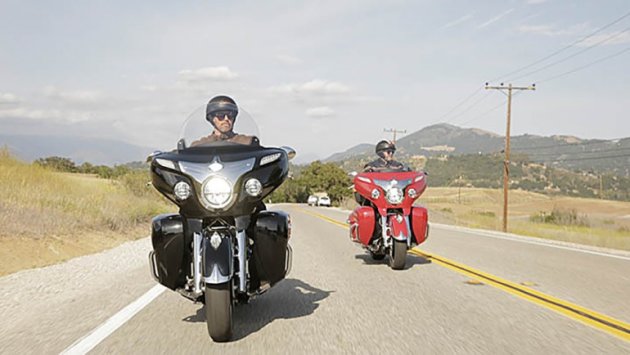
After several limp attempts at resurrection over the ensuing decades, Indian has finally found a strong financial backer in powersports giant Polaris, also the parent company of Victory Motorcycles. According to Polaris, Indian motorcycles and Victory bikes share a very small percentage of parts – just fasteners and other universal parts that make sense. All engine, frame, transmission, electricals and other components are uniquely designed, engineered and manufactured for each respective brand. There will be some crossover in dealer network, supply chain, transportation and other aspects of business, but other than that, Indian and Victory are separate brands.
In addition to the Roadmaster, the 2015 Indian lineup consists of the Chief Vintage, the Chief Classic, the Chieftain, and the new Scout.
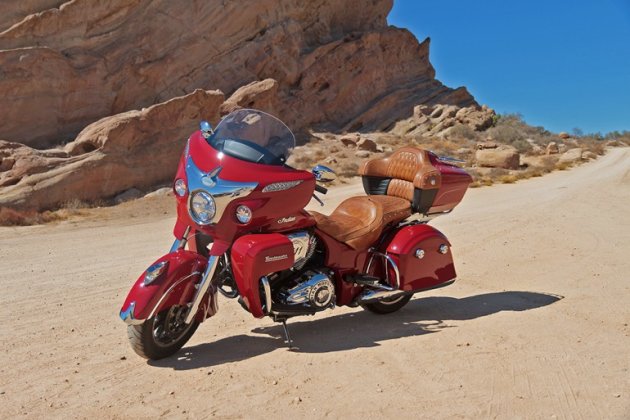
The Roadmaster revives the top-of-the-line name from the 1940s, when the three Chief trim levels were Clubman, Sportsman and Roadmaster. Back then, a Roadmaster came with a windshield, leather saddlebags, a sprung two-up seat and lots of chrome. It was a beautiful bike, easily recognizable by its deeply valanced front fender crowned by lighted Indian head marker light, and a chrome luggage rack out back.
The new Roadmaster wears a front upper and lower fairings, a pair of hard saddlebags, and a trunk. Several design features echo the classic Indian. Once again, there’s a deeply valanced front fender with a lighted Indian head. There’s a chrome luggage rack on top of the trunk lid. There’s a Roadmaster badge on each side of the lower fairings. The bike is at once an homage and an update to the Indian aesthetic, executed with taste and an eye for detail. To my eye, Indian has succeeded in their stated goal of designing a bike that respects the original, yet brings it into the present day. This might look like the bike that Indian would have evolved into if they had never gone out of business in 1953.
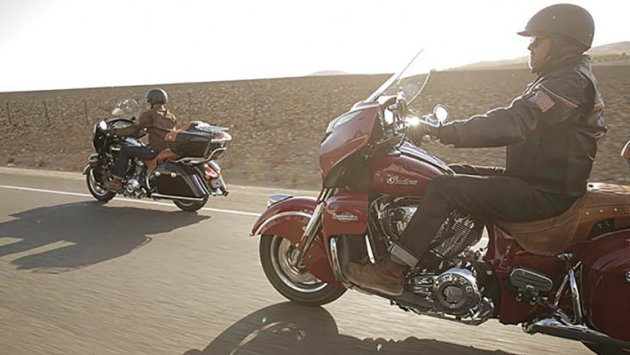
The Ride
I had the Roadmaster for a couple of weeks, during which I made an effort to ride the bike in a wide variety of conditions on as many roads as time would allow. Because we’re in the middle of an epic drought here in Southern California, and on top of that, my loan coincided with a horrendous triple-digit heat wave, I didn’t get to ride in the rain or the cold. My longest dedicated ride was about 100 miles, and I used the bike for short hops and everything in between. I spent time on wide open freeways, on congested, bumper-to-bumper commuter routes, on suburban streets and country roads. I took a nice weekday ride on the Angeles Crest Highway, one of my favorite local roads and a fantastic place to challenge a big motorcycle’s cornering and handling characteristics. I even traversed a few miles of dirt/gravel road in search of a great photo venue.
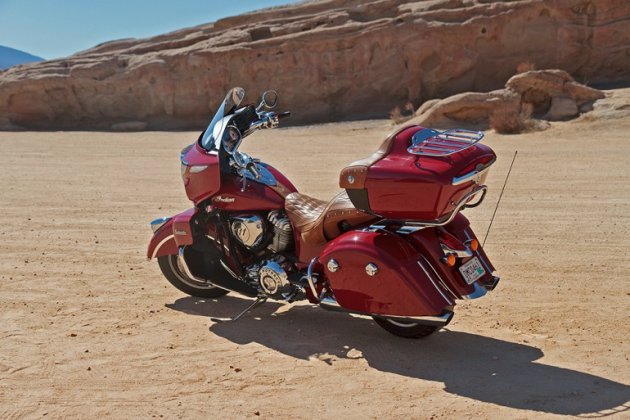
I do a lot of motorcycle travel, mostly on new Harley-Davidson Electra Glide models, and that formed a good basis for my evaluation. I have also toured on a Honda Gold Wing, a Kawasaki Concours 14 ABS, and I’ve spent a good amount of time riding the current crop of ADV bikes. I’ve only spent a few hours on the BMW K1600 LT and R1200RT – just enough to get the flavor, but not a really deep dive. I’ve also taken rides on the Kawasaki Vulcan 1700 Voyager ABS and Star Stratoliner, as well as the Victory Cross Country, so I’ve ridden a good cross section of the Roadmaster’s competitors.
The Roadmaster handles very well at low speeds, and feels like it has a low center of gravity. Parking lot maneuvers and U-turns are drama-free, despite the bike’s claimed 897 lb dry weight. That’s heavier than the comparable Harley-Davidson Ultra Limited (861 lbs) and the Indian Chieftain (815 lbs). I was careful to park the Roadmaster in positions where I could lift if off of the sidestand without struggling, and where I’d be able to ride off without backing up – there’s no reverse gear on the six-speed transmission.
On the open road, the Roadmaster handles like a dream. It is solid, planted, and undisturbed by cross winds. It soaks up the miles, just like a touring bike should. When traffic gets tight, the bike’s width is predictable, as the back of the bike is no wider than the front. So, lane sharing is possible in many situations (it’s still legal here in California) if done with care. Maintaining balance at low speeds in bumper-to-bumper traffic is easy – as long as you’re moving forward with the clutch out, you can keep your feet on the floorboards and avoid paddling.
On the twisty stuff, the Roadmaster handles with grace that belies its weight – that low center of gravity feeling again taking effect. Changing direction is not quite as easy as flicking a sportbike from side to side, but the bike responds predictably to smooth inputs, and has enough ground clearance to allow for a generous lean. The first part to touch down is the hinged floorboard, so a scraping noise lets you know that you’re reaching your cornering limits.
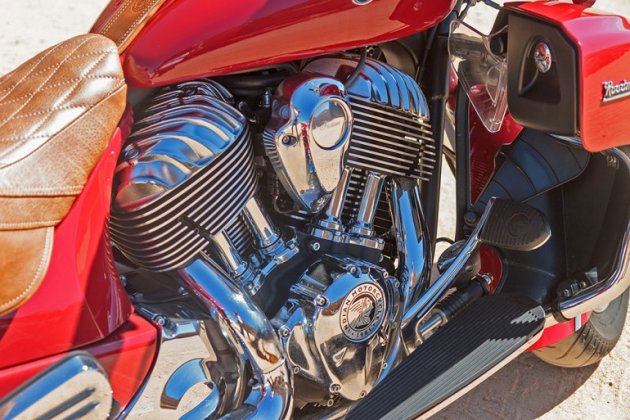
Engine
The Roadmaster gets the same air/oil-cooled 49-degree V-twin as the Chief, the 111-cubic inch Thunderstroke 111 that Indian claims puts out 119 lb-ft of torque (they don’t quote a horsepower figure). This engine was developed from scratch for the new Indian lineup, and it is really what makes the bikes different from every other attempt to revive the brand.
The technology is a mix of conventional and advanced. The fact that the engine is air-cooled, with two valves per cylinder and hydraulic lifters fits the conventional mold. Things get a little more adventurous and advanced with a direct drive connection between the clutch and six-speed transmission, three cams, a helical driven primary balancer and throttle-by-wire.
On the road, the Thunderstroke 111 is a great match for the Roadmaster. Power is ample, and spread out over the torque curve so that it feels like the bike can pull hard at any RPM. The action from the electronic throttle is nicely modulated, so it’s easy to ride smoothly and to hold a constant speed manually. When that gets old, you can thumb on the cruise control and the bike does the hard work for you. I’m not usually a cruise control guy, but I liked how well it worked on long open stretches.
Clutch pull on the Roadmaster is medium light, and the shifting action is smooth and quiet, without the big thunk that plagues big engine bikes when downshifting into first from neutral. At highway cruising speed, the engine lopes along comfortably in sixth gear, the balanced performance keeping vibration at bay. This is an all-day engine in an all-day bike.
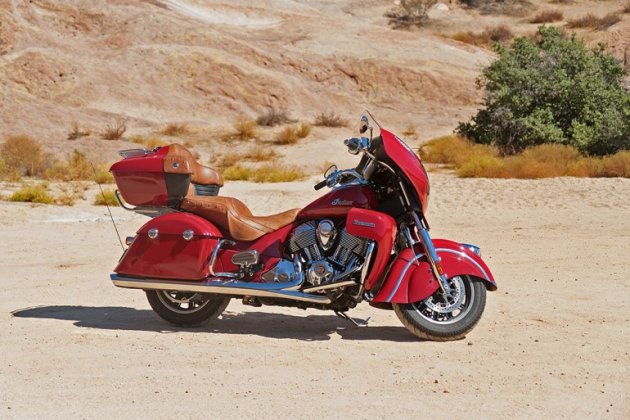
Chassis/Suspension
Another big differentiator for the Roadmaster is its cast aluminum frame, which weighs less and is more rigid than a conventional tubular steel frame. That rigidity translates directly to solid road feel, especially in situations where the bike is stressed, like hitting bumps mid-corner.
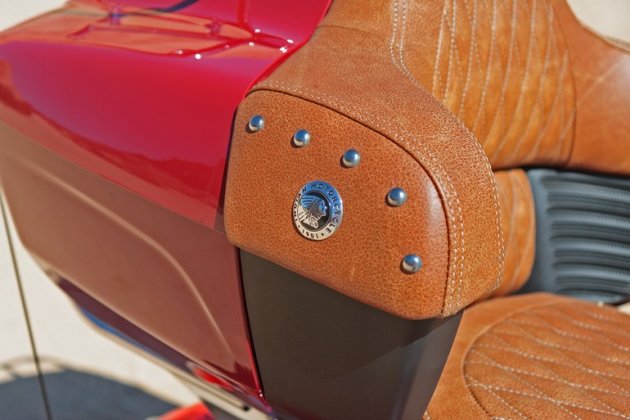
The frame works in concert with the suspension, obviously. Up front, there’s a 46 mm telescopic fork with 4.7” of travel. Out back, a single lay-down shock with 4.5” of travel hides in the frame. The shock is adjustable with an included hand air pump. Just connect to the Schrader valve on the side of the bike and pump up to the recommended pressure for your payload (your weight plus passenger and cargo). Remember that you’re probably wearing a good 10 lbs of gear, too. The generous rear travel delivers a compliant ride, soaking up smaller bumps without camouflaging road feel. I appreciated the adjustability in the rear, and found the factory recommendations to be spot on for comfort and control.
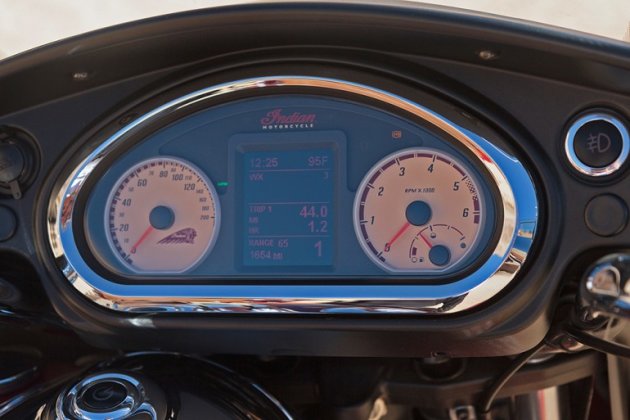
Technology
Beyond the engine, transmission and suspension technologies, Roadmaster gets some luxury and touring tech that is worth noting. Standard heated grips and a dual-heated seat (rider/pillion) are definitely luxury features, and much appreciated on a cold morning (though not much good in the triple-digit heat). A power adjustable windshield, reshaped from the Chieftain, gives a good range of movement to help find the right airflow for your height and riding position. Keyless ignition and remote locking storage brings automotive-style convenience.
Roadmaster also gets full-LED lighting, including a Pathfinder headlight and foglights. LED lighting is great technology for bikes, with low power demands, great resistance to vibration and long service life. The Pathfinder headlight is bright and powerful, throwing a clean beam that greatly improves nighttime visibility.
Roadmaster gets an AM/FM/WB/AUX sound system with Bluetooth capability. You can connect an iPod or other MP3 player to the bike via a USB connection in the upper fairing, where there is a compact (non-lockable) compartment to hold your device. There are two pairs of speakers on the bike, in the upper fairing and in the trunk, but there’s no way to connect a hardwired headset or intercom. A glaring omission in the luxury touring class is the fact that there’s no factory navigation available on the Roadmaster. Whether you like GPS navigation or not, it’s becoming standard equipment on some touring bikes, including the H-D Ultra Limited.
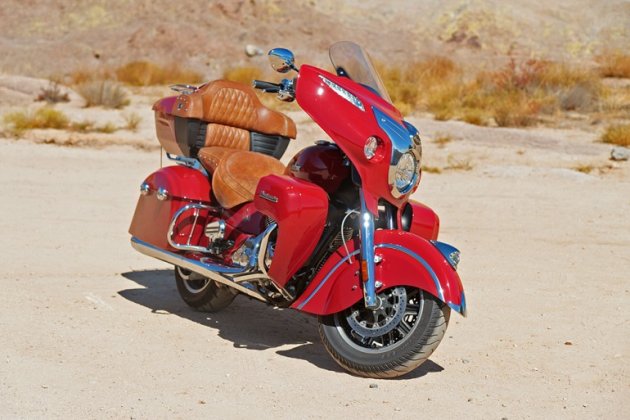
Ergonomics
A big component of luxury is comfort, and Roadmaster has that covered. The heated, leather-covered seat is supportive yet nicely padded. I’m 6’2” tall with a 32” inseam (short legs, long torso), and I wear 36” sleeves. I know, kind of gorilla-like proportions. Add to that the fact that I wear size 14 boots, and you can see that I’m some kind of prize. All of which I mention to put my comments about comfort into perspective. I had no problem wrapping my legs around the Roadmaster’s 5.5-gallon fuel tank, or reaching the ground flat-footed from the 26.5” high seat. The low seat height would be essential for a shorter rider, because the bike is too heavy to balance safely from one side with just one leg touching the ground. I could have used a little bit more foot and leg room as rides got longer – which I would probably remedy with a set of highway pegs mounted on the front engine guards. The reach to the handlebars worked for me, and there appears to be a good amount of adjustability built in with a simple twist of the bar.
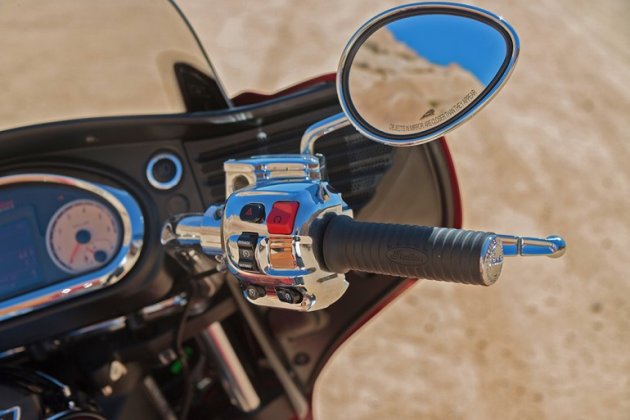
The Price
The 2015 Indian Roadmaster starts at $26,999 in Thunder Black; $27,599 in Indian Motorcycle Red; and $28,1999 in two-tone Indian Motorcycle Red and Ivory Cream.
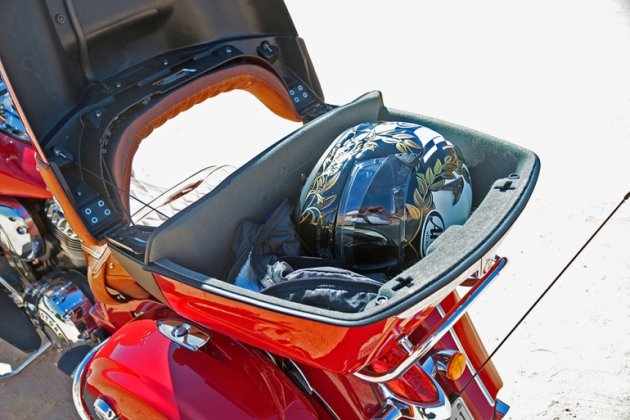
The Verdict
Indian has done a great job of ramping up from a dead start to compete in a very important market segment: Full-Dress Touring. Even though there are a few bikes in the category, let’s be honest – most riders who are considering buying a Roadmaster are going to measure it against the Harley-Davidson Ultra Limited. In many ways, the bikes are very close, with the differences a matter of taste rather than quality. In other ways, the Roadmaster is a better bike. The Thunderstroke 111 is a great engine and the chassis on the Roadmaster is fantastic with a minimum of flex. The Harley has the edge in terms of infotainment and telematics, with intercom, headset outlets and navigation as part of the package. Harley has the additional advantage of a long-established dealer and service network, demonstrated solid resale value and brand stability. Though I have a lot of confidence in Polaris, Indian’s parent company, there’s no doubt that the smart money is still on Harley. So, which one would I buy? Depends on when you ask me. If I were about to head off on a long road trip, I still think I’d want the Harley. That integrated GPS navigation works really well, and I’ve become pretty addicted to it already. If I were staying closer to home, riding familiar roads and showing off my bike to friends, I’d be proud to ride up on an Indian Roadmaster, which might be the most beautiful new bike made right now. I’d have to flip a coin, and then flip it again about a hundred times. The bikes are that close for me, all things considered.
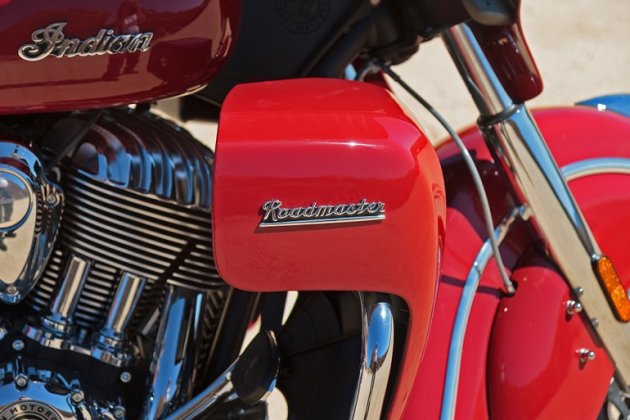
If we’re lucky, both Indian and Harley-Davidson will become dissatisfied with this near parity, and they’ll both use it as a reason to innovate and improve their products. Hopefully, we’ll be living in another great age of motorcycles – the next Harley and Indian Wars.
Gear
Jacket: Alpinestars New Land Gore-Tex Jacket
Boots: Wolverine DuraShocks® Gore-Tex Waterproof Composite-Toe EH 6″ Work BootPants: Pants: Sliders All-Season 2 Motorcycle Riding Pants
Lid: Arai Signet-Q
(the only riding shots are provided from Indian Motorcycles, but the above gear is Jason’s daily stuff.)
The Rider
Every rider has his or her own style, size and weight. We decided to put things in perspective and show what each reviewer weighs and their experience.
Weight: 260 lbs
Height: 6’2”
Build: broad shouldered, tall, heavy build
Experience: riding on the street for over 30 years
Specialty: motorcycle touring, cruisers

